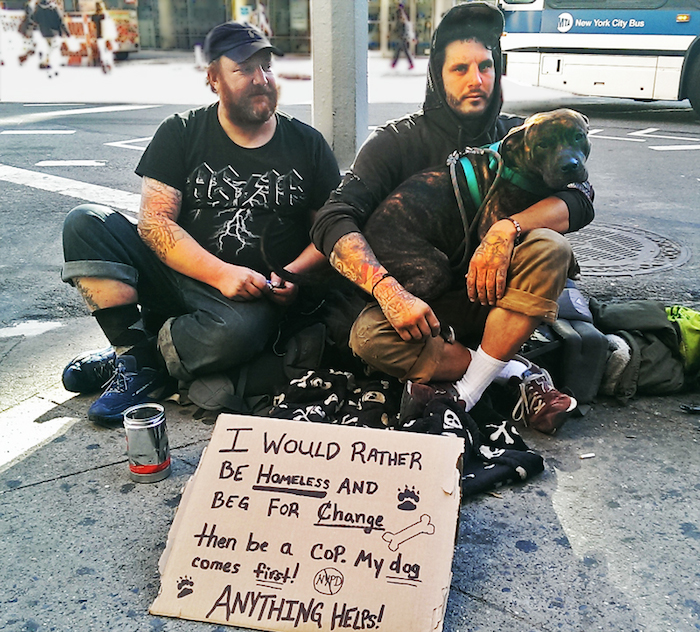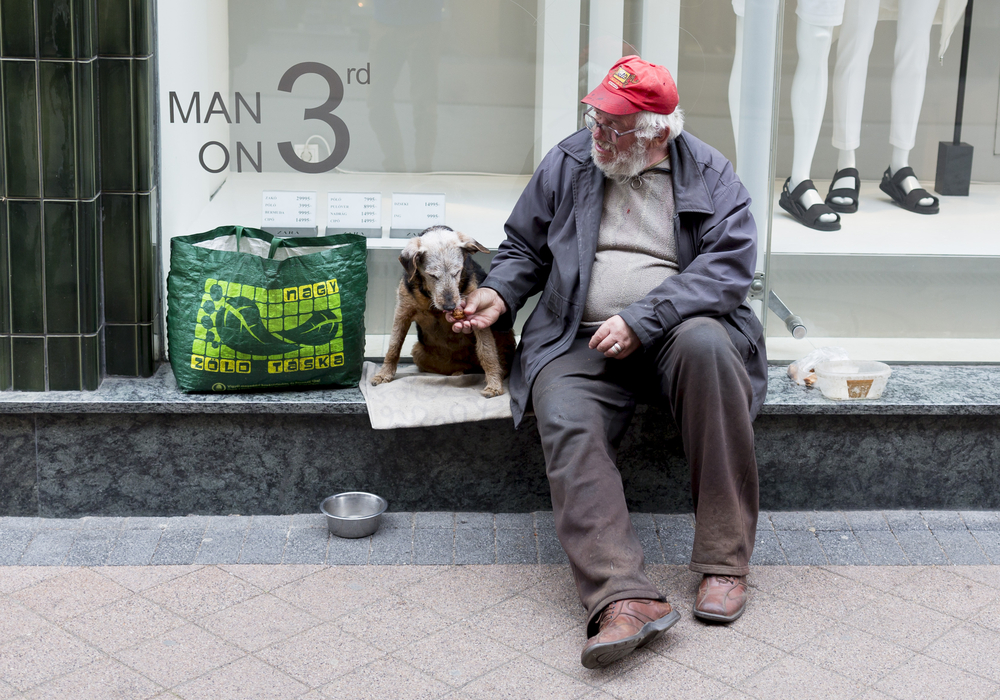
Michael, Wayne and Gonzo, New York City. Photo: Michelle D. Land
Ed. Note: Michelle D. Land, JD is director of the Pace Academy for Applied Environmental Studies and director of the Environmental Consortium of Colleges & Universities. This post first appeared on the Animal Blawg. ~ JC
WHEN WAYNE AND HIS DOG, GONZO, SLEEEP AT NIGHT, Gonzo is both alarm and shield. “If someone is trying to wake me up, Gonzo doesn’t bark, he just lays across me. Same thing if it is raining or there is something going on that I should know about.”
Throughout most of my twenty-minute conversation with Wayne, Gonzo, a brindle pit bull, lay on his blanket curled up, oblivious to my presence. But there was a palpable feeling of interdependence between the two, as there usually is between the homeless and their companion animals.
To homeless pet guardians, their animals are sources of emotional support: friendship, companionship, unconditional acceptance, reduced loneliness, and love. They are “family” and “friends.” They facilitate contact with those who might not otherwise communicate with a homeless person, thereby reducing the social isolation so common to many homeless. They can be strong motivators, providing a sense of responsibility and purpose. Most important, especially in the case of youth, caring for a pet can help the homeless to develop healthier coping mechanisms, strive to stay out of trouble and take better care of themselves.
The pets can be beneficiaries as well. Wayne proudly showed me Gonzo’s mulepack-style saddlebag designed for dogs. A homeless support program gave it to him. Gonzo likes to carry his own things, Wayne explained, because it gives him a sense of purpose. Many a parent has spoken similarly of a child and her backpack. But Wayne was also noting the contrast between Gonzo’s life on the street and the life of a domiciled dog. Most of us must leave our pets home alone for as long as eight to twelve hours a day. Gonzo is with Wayne at all times and has the benefit of constant interaction, socialization and enrichment.
“Homeless pet owners constitute a hidden population.
According to the U.S. Dept. of Housing and Urban Development (HUD), there were roughly 578,000 people homeless on any given night in January 2014. However, roughly 3.5 million will experience homelessness at some point within the year. The National Coalition for the Homeless estimates homeless pet owners as 10% of the total homeless population. In some areas, social service providers, including the not-for-profit, Pets of the Homeless, put the figure closer to 25%.
The estimates vary because homeless pet owners constitute a hidden population. Some are secretive for fear of their pets being confiscated. And, because pets (especially dogs) are not allowed in most shelters, homeless guardians do not appear on counts. The number of animals with homeless persons is still staggering: 350,000 to 875,000 of those experiencing homelessness within the year have pets.
Pet ownership can also be a barrier to support services. Most healthcare facilities, public transportation, shelters and other housing services do not permit pets. In simple terms, this means those with pets are not able to see a doctor, participate in job-finding services, ride a subway to seek support, or stay in temporary housing (including motels). Researchers report that homeless, particularly youth, refuse housing if they must be separated from their animals (Rhoades, Winetrobe and Rice, 2015). This mentality does not stray far from domiciled citizens. Most of us would rather accept less-than-ideal circumstances than be without our animal companions.
Compounding their daily challenges, the homeless are criticized and stigmatized for having pets. They are often harassed or confronted by passersby, enduring insults inferring they have chosen their fate, such as: “you shouldn’t have a dog if you can’t take care of yourself,” or “you are being selfish,” and “your dog/cat doesn’t get a choice about being homeless.”
The domiciled accuse homeless persons of keeping pets to gain sympathy when panhandling. Some people even offer to buy the pets, ignoring entirely the human-animal bond may be more important than money. The worst, of course, is many homeless live in fear of their pets being confiscated by the authorities. Wayne suggested to me the NYPD is eyeing homeless youth and their animals with increased vigor.

Homeless man feeding his dog. Cylonphoto / ShutterStock. Used with permission.
For her book, My Dog Always Eats First: Homeless People & Their Animals, Leslie Irvine formally interviewed seventy-five homeless pet guardians around the country. What she heard echoed my own experience talking with Wayne and others like him: “my dog eats before I do,” and “when I don’t have any money sometimes for food, I’ll give them what I’m eating and go without food; I won’t let my animals go hungry.” They often describe how their animal is cared for better than most domiciled pets.
Numerous private organizations provide essential services for the homeless with companion animals. Pets of the Homeless is a national not-for-profit that:
[F]ocuses on coordinating pet food and supply donations from more than 260 sites across the country, arranging free emergency veterinary care, wellness clinics for nonemergency care like vaccinations and neutering or spaying services and, most importantly lobbying efforts to allow homeless shelters to let pets join their owners indoors.
A NYC-based ministry, called Collide, focuses on supporting homeless youth and their animals in the East Village and Lower East Side.
But public institutions should demonstrate the same compassion. Irvine makes the compelling case in her book:
It is important that service agencies recognize the strong bonds between homeless pet owners and their companion animals. Ideally, agencies serving homeless pet owners would consider the homeless person and his/her pet to be a unit and strive to house and serve the unit, even at healthcare facilities.
The mutual dependence among animals and their homeless persons is profound and real. Public agencies should review, update and create policies that support the human-animal homeless unit regarding housing, transportation, healthcare, veterinary care, and job-seeking services.
And in case you wondered about Wayne’s traveling partner, Michael (left in the photo above), he “retired” his companion dog to a family member’s farm. He believed it was getting too old to live comfortably on the street.









